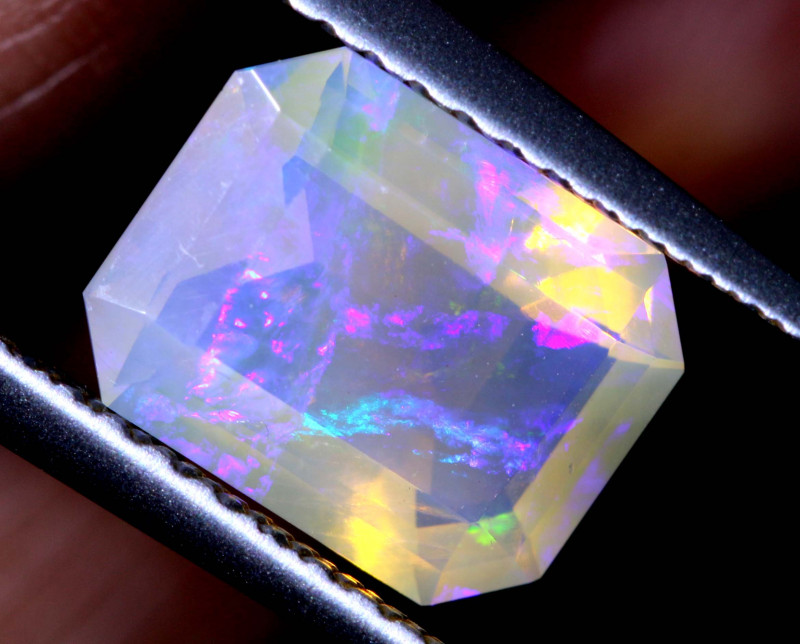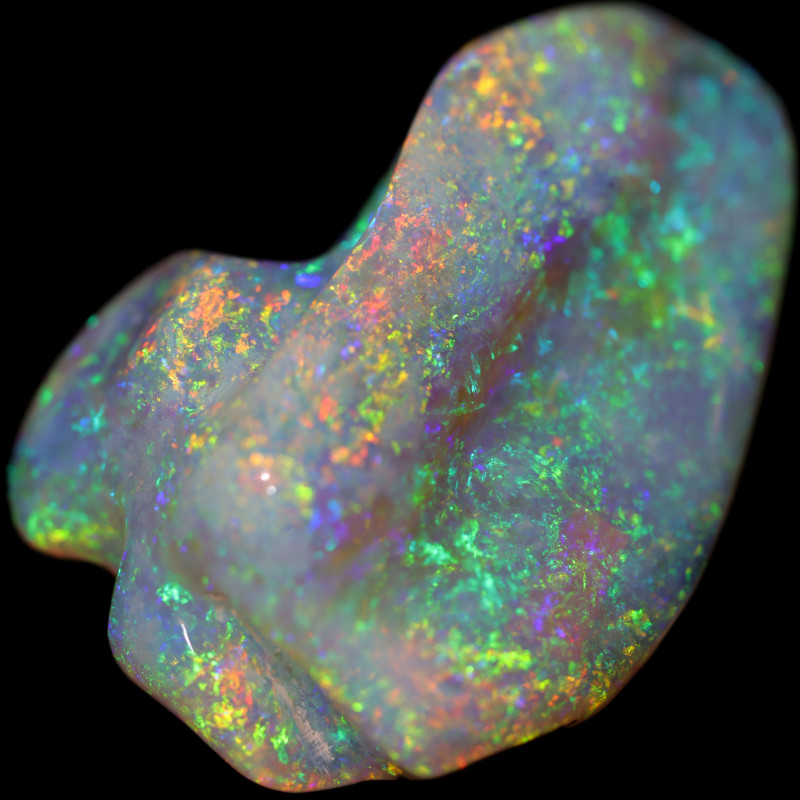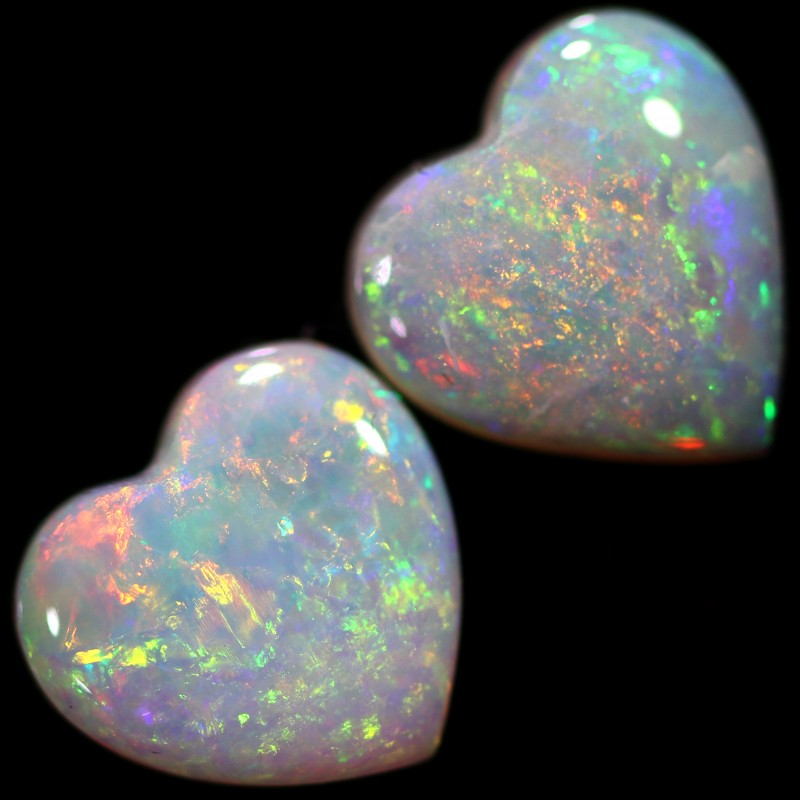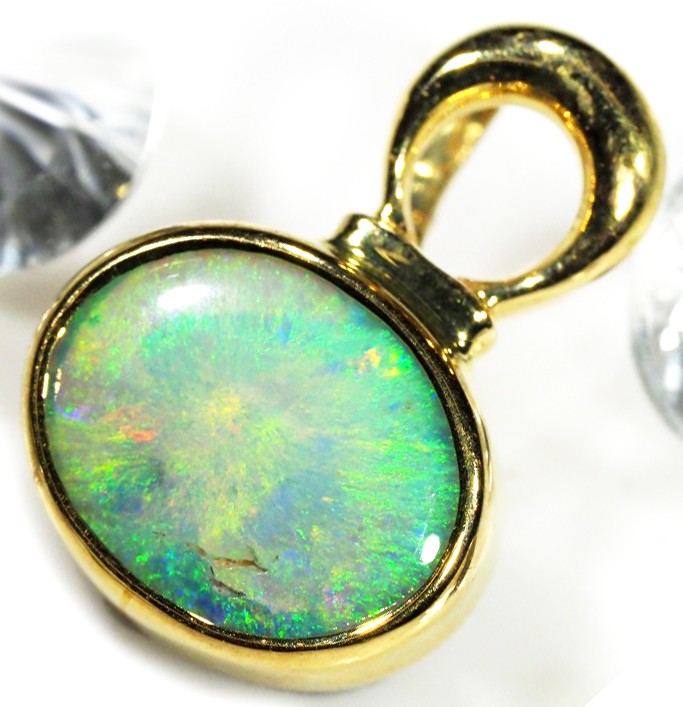
Crystal Opals: History, Symbolism, Meanings & More
 Crystal opals are an opal variety renowned for their translucence and transparency. The light easily passes through the surface and into the core of the stone, giving them mesmerizing iridescence.
Crystal opals are an opal variety renowned for their translucence and transparency. The light easily passes through the surface and into the core of the stone, giving them mesmerizing iridescence.
Opal is the official gemstone of Australia, as the nation produces over 95% of the world's precious opals! In fact, the largest opal in the world (and the most valuable) is called Olympic Australis, after the nation where it was found!
One of the most famous crystal opals is The Queen's Opal, mined from the Andamooka opal fields. The stone was cut into a jewelry set and given to the Queen of England as a gift from the Australian government.
In this article, we'll go over the basics of what a crystal opal is, where it's found, what it means, and how you can use its healing properties!

What Is A Crystal Opal?
Crystal opals, like all opals, are made of hydrated, non-crystalline silica. Because of their amorphous structure, opals are not minerals but mineraloids, alongside substances like amber, coal, and obsidian. Opal's chemical formula is SiO2·nH2O.
Color
Because opals are iridescent, they can show off a few different colors. Classifying an opal’s color involves looking at the background color and range of iridescence inside.
Opal background color can be white, black, or clear. Crystal opals are defined by their clear background. However, some opal graders consider white or black opals to also be crystal opals if their background is translucent or clear instead of opaque.
One of the most beloved traits of opals is their ability to reflect any number of different colors. The color effect seen in opals is called “play-of-color,” which describes the fiery illumination of colorful patterns and flames that blaze from an opal gemstone.
An opal’s range of color is a determining factor in its price; an opal that shows flashes of the entire rainbow or numerous colors will cost much more than a purely blue or red opal.
Mineral Hardness
Opals range in hardness from 5.5-6.5 on the Mohs mineral hardness scale. While it’s certainly not the weakest gemstone, it’s still susceptible to damage and scratches from other minerals or metals.
To keep your crystal opal jewelry looking fresh and new, make sure to take it off before engaging in exercise, operating machinery, or starting any activity that could risk scratching it.
After years of wear, you can bring your opal jewelry to a professional opal cutter, who can polish the surface and restore your stone’s beautiful shine.

Cut
Opals are most often cut and polished into cabochons to best display the stone's iridescence. Plus, many precious opals are semi-opaque, which can result in a dull look when faceted.
Crystal opals have the benefit of being mostly or entirely clear, producing a stunning luster when faceted. Faceted crystal opals can almost resemble an iridescent diamond, making them spectacular in engagement rings and other high-quality jewelry.
Before they’re faceted, where do crystal opals come from?
Where is Opal Found?
Opal is found in many places, but the most productive deposits are in Ethiopia, South Africa, Australia, and Mexico.
Crystal opals can be found in the same locations as other opals. However, certain regions and towns are famous for their high volume of crystal opals.
One region, in particular, is Andamooka, Australia, where the largest crystal opal was found!
Are Crystal Opals Valuable?
Crystal opal prices are usually higher than other opal varieties. These stones may cost up to $1,500 per carat, depending on the quality.
Crystal opal value can change depending on the stone's clarity, color, size, and cut.

Crystal Opal Gemstone Properties
Are opals gemstones? If you ask a geologist, they’d probably say no.
While crystal opals may have crystal in their name, they don't have a crystal structure on a microscopic level -- they're considered "amorphous" or "glassy" solids like all other opals. Confusing, we know!
However, jewelers will use opals as gemstones because of their beauty, rarity, and almost otherworldly iridescence. Because of this, opals are often colloquially referred to as gemstones.
Crystal Opal Properties
Opals are divided into two forms: common and precious.
Precious opals are known for their "play-of-color," the color-changing spots caused by the diffraction of light. You'll see precious opals included in most opal jewelry; think of an opal, and chances are it's a precious one.
By contrast, common opals are less commonly featured in jewelry, as they’re completely opaque with no play-of-color. Common opals still have a milky iridescent sheen, but it's more muted, especially when compared with the jaw-dropping flashes of light from their precious counterparts.
Crystal opals, as their name may imply, are precious stones. They are translucent unlike common stones, and they show off their brilliant plays-of-color easily through their clear backing.
Opal stones can have inclusions, or bits of other stones, minerals, or organic matter, embedded inside of them.
Some types of opal are prized for their inclusions, such as moss opal, a common opal with chlorite inclusions resembling tree branches.
Cat’s-eye opals are common opals known for small, needle-like inclusions that give the illusion of one vertical flash of light across the surface of the stone, like a cat's pupil.
Precious opals can feature inclusions as well, ranging from water bubbles, air bubbles, fossils, or minerals.

How Do Crystal Opals Form?
Opals form when silica spheres are carried into cracks in the earth via groundwater and deposited on top of one another to form layers.
The water eventually evaporates, and the silica layers grow throughout millions of years until you get opals. The uniform layers of spheres create the diffraction that allows for play-of-color.
The size of the spheres, material, and uniformity of the layers can all determine the opal's appearance, including whether or not it’s transparent.
Crystal Opal vs. White Opal
Opal background color (or body tone) is graded on a scale from N1 (black opals) to N9 (white opals). Note that an opal’s color does not determine if it’s a crystal opal -- both black opals and white opals can be considered crystal opals if they’re mostly transparent or translucent.
Opal graders will often shine a flashlight through stones to see if they are crystal opals. If light gets through or shapes can be seen through the stone, it's crystal opal.
Through non-crystal opals, the light will appear milky or not shine through at all. White crystal opals and black crystal opals are considered rarer and more beautiful than standard non-crystal opals because their colors are more vivid.
How Can You Tell If a Crystal Opal is Real?
Fake opals can sometimes be nearly indistinguishable from real opals, especially if you're not a gemologist. However, there are some telltale signs that you're dealing with a fake:
First, does the iridescence look like metallic foil? Or does the stone have an unusual pattern that looks unlike real opals? You might be looking at a foil opal, an old method of creating synthetic opals.
Next, does the backing look like hard plastic? Is it opaque under the top layer? It could be a doublet or triplet opal. Doublets and triplets are thinly sliced opals (which may be natural or synthetic) placed on a piece of stone or plastic backing to give the illusion of a larger opal.
Lastly, are the light patterns too uniform? Or do the patterns resemble snakeskin? Both are signs of synthetic opal. Lab-made opals are often a little too uniform, creating an inorganic look.

Crystal Opal History
The source of the word "opal" is a bit unclear, but there are three main theories from etymologists.
One argument claims opal came from the Sanskrit word, upala, meaning "precious stone." From there, the word was Romanized, eventually leading to the modern spelling.
Another theory contends the origin is Greek, from the word opallios, which could mean either "see" or "other." From there, scholars say the word could mean "to see a change in color," referring to the stone’s play-of-color.
Finally, some scholars claim the word comes from Ops, the Roman goddess of fertility.
Beyond etymology, what is the history behind the opal?
Opals have been known to humans since 4000 B.C., evidenced by ancient opal artifacts found in Kenya’s Nakuru Cave. Throughout time, these stones have been highly coveted as signifiers of wealth and luxury.
Before the mid-1800s, high-volume opal deposits were all around Europe, notably Eastern Europe, while Spanish rulers often sourced their opals from Mexico.
The opal industry started booming when opals were discovered in Australia in the mid-1800s. Queen Victoria flaunted Australian opals to show off her wealth and boost her colony's economy. This strategy worked and the market exploded!
Soon, licensing came about for opal mines, and Australia’s now-famous opal fields became major players in the industry.

Crystal Opal Meaning & Symbolism
Opal has had a somewhat fraught reputation, considered in equal measures divine and mysterious while also being a sign of bad luck and misfortune.
However, despite persisting myths about opals being “cursed,” this reputation only really began in the 1800s after the publication of Sir Walter Scott’s novel Anne of Geierstein.
Ancient cultures like the Greeks coveted opals for their beautiful range of colors, and folks during the Middle Ages believed opals could bring good luck.
Indeed, many spiritual practitioners have reclaimed opal as a stone of many virtues.
Crystal Opal Spiritual Meaning
What about opal crystal properties in spiritual practices? For many centuries, opal was considered a powerful stone for intuition, clarity, hope, and emotional release. The stone also represented purity and enhanced spiritual awareness.
But what does crystal opal represent?
Crystal opal is associated with joy, creativity, and art. The stone's unique clarity is thought to make them gazing stones, used to see visions of other realms.
White opal properties and white opal meanings mostly match up with that of crystal opals, since both opal varieties often bear a strong resemblance.
Crystal Opal Healing Properties
According to spiritual practitioners, opals offer specific emotional and spiritual healing abilities. Some claim opals possess physical benefits as well.
So, what is the crystal opal good for?
Some purported benefits of crystal opals include:
Improved eye, kidney, and skin health.
Improved memory.
Improved water balance within the body.
Better emotional awareness.
Protection from the emotions of others.
Stimulating spontaneity and creativity.
Releasing inhibitions and intensifying emotions.
Improving foresight and spiritual clarity.
Crystal Opal Chakra
Crystal opal is best for the crown chakra, which controls your thoughts and other cognitive functions.
Crystal opal can provide you with clarity and connection in the earthly world while protecting you from the thoughts and feelings of others.
Some signs that your crown chakra is blocked include lack of focus, disconnection from the world around you, and poor balance. Unblocking the chakra with crystal opal can allow you to connect better with higher energies and improve your spiritual awareness.

Add Crystal Opals to Your Jewelry Box!
Opals have been coveted for centuries, and crystal opals are among the most beautiful varieties. Their rarity and value do not seem artificial or inflated when you see their splendid appearance and know their wealth of healing uses.
Whether you use them for healing or not, crystal opals delight with their beauty. Wearing an Australian crystal opal ring can feel like having lightning captured on your finger.
As famed Roman naturalist Pliny the Elder observed:
"For in them you shall see the living fire of ruby, the glorious purple of the amethyst, the sea-green of the emerald, all glittering together in an incredible mixture of light."
Search the Opal Encyclopedia
Related Auctions
Related Articles
Ethiopian opals are a relatively new group of hydrophane opals with impressive play-of-color in a variety of patterns. Learn the history and uses of Ethiopian opals!
23rd May 2018
Learn about all the different opal types and meanings in this comprehensive guide, plus how to classify them by color, inclusions, formation, origin, and more!
22nd May 2017
As well as Opal being an amazing gemstone there are many other references to Opal across the world. Here are some of the most well know.
1st Mar 2018
Latest Articles
An opal’s price comes down to a variety of factors, all of which we’ve broken down in this guide to opal grading and prices. Learn all about opal grading and the prices of each type of opal!
19th Jul 2023
Come on a journey and learn about the healing power of opals from our guest writer Vivien Schapera from Crystal Healing Techniques!
20th May 2023
The Flame (or Fire) Queen opal is the world’s most expensive opal, sold for the modern equivalent of $3 million dollars. Learn all about its history and qualities!
18th Feb 2023
Article Categories
All there is to know about Opals including Black Opals, Ethiopian Opals & Boulder Opal
15 Articles
Check out our fascinating information and articles on all things amazing in the Opal world
43 Articles
Opal Auctions sellers who are approved as opal Verified Sellers
4 Articles





